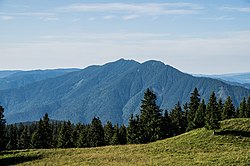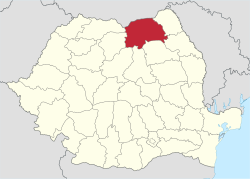
Back Propinsi Suceava ACE Provincia de Suceava AN إقليم سوتشيافا Arabic Suçava (judets) Azerbaijani Сучава (жудзец) Byelorussian Сучава (окръг) Bulgarian Suceava (okrug) BS Província de Suceava Catalan Suceava (lalawigan) CEB Sučava (župa) Czech
Suceava County
Județul Suceava | |
|---|---|
 Rarău-Giumalău mountainous range in Suceava County, Bukovina, northeastern Romania | |
 | |
| Coordinates: 47°35′N 25°46′E / 47.58°N 25.76°E | |
| Country | Romania |
| Development region | Nord-Est |
| Historical region | Southern Bukovina |
| Seat | Suceava |
| Government | |
| • President of the County Board | Gheorghe Flutur (PLD) |
| • Prefect | Gheorghe-Alexandru Moldovan |
| Area | |
| • Total | 8,553 km2 (3,302 sq mi) |
| • Rank | 2nd |
| Population (2021-12-01)[1] | |
| • Total | 642,551 |
| • Rank | 8th |
| • Density | 75/km2 (190/sq mi) |
| Telephone code | (+40) 230 or (+40) 330[2] |
| ISO 3166 code | RO-SV |
| GDP (nominal) | US$3.188 billion (2015) |
| GDP per capita | US$5,022 (2015) |
| Website | County Council Prefecture |
Suceava County (Romanian pronunciation: [suˈtʃe̯ava]) is a county (Romanian: județ) of Romania. Most of its territory lies in the southern part of the historical region of Bukovina (Romanian: Bucovina), while the remainder forms part of Western Moldavia proper.
The county seat is the historical town of Suceava (German: Suczawa, also Sotschen or Sutschawa; historically known in Old High German as Sedschopff as well)[3] which was the capital of the Principality of Moldavia during the late Middle Ages and then a pivotal, predominantly German-speaking commercial town of the Habsburgs, Austrian Empire, and Austria-Hungary at the border with the Romanian Old Kingdom (Romanian: Vechiul Regat, German: Altreich) throughout the late modern period up until 1918, when, after the end of World War I, the town became part of the enlarged Kingdom of Romania.
Suceava County, as part of the historical and geographical region of Bukovina, had been sometimes described as 'Switzerland of the East'.[4][5][6] It has also been known as 'Switzerland of Eastern Europe' in the minds of the educated public.[7]
- ^ "Populaţia rezidentă după grupa de vârstă, pe județe și municipii, orașe, comune, la 1 decembrie 2021" (XLS). National Institute of Statistics.
- ^ The number used depends on the numbering system employed by the phone companies on the market.
- ^ Johann Schiltberger. Hans Schiltbergers Reisebuch Tübingen, Litterarischer Verein in Stuttgart, 1885, p. 111
- ^ Sophie A. Welsch (March 1986). "The Bukovina-Germans During the Habsburg Period: Settlement, Ethnic Interaction, Contributions" (PDF). Retrieved 6 October 2021.
- ^ Gaëlle Fisher (20 November 2018). "Looking Forwards through the Past: Bukovina's "Return to Europe" after 1989–1991". Lean Library. 33: 196–217. doi:10.1177/0888325418780479. S2CID 149895103. Retrieved 6 October 2021.
- ^ David Rechter (16 October 2008). "Geography is destiny: Region, nation and empire in Habsburg Jewish Bukovina". Journal of Modern Jewish Studies. 7 (3): 325–337. doi:10.1080/14725880802405027. S2CID 142797383. Retrieved 6 October 2021.
- ^ "Ștefan cel Mare" University of Suceava (USV). "Bucovina. Past, present and perspectives". "Ștefan cel Mare" University of Suceava (USV). Retrieved 26 September 2022.
© MMXXIII Rich X Search. We shall prevail. All rights reserved. Rich X Search
